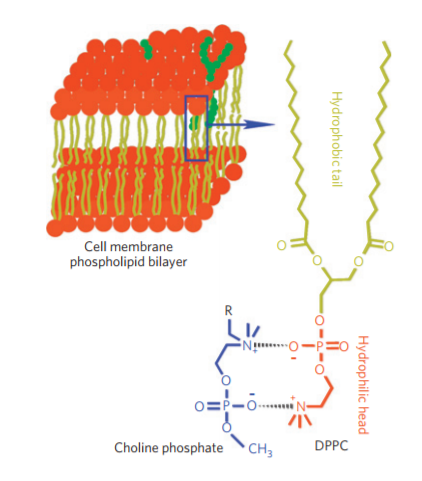 By Erika Siren, PhD Student, Kizhakkedathu Lab, CBR
By Erika Siren, PhD Student, Kizhakkedathu Lab, CBR
In emergency medicine, there is a constant need for simple, robust methods to control traumatic hemorrhage. This form of trauma is made especially challenging when hemorrhages occur in remote locations lacking well-equipped medical facilities. With almost half of mortalities related to hemorrhage occurring within the first 24 hours, low-tech strategies to quickly control hemorrhages are crucial in these circumstances. To address this issue, a team of chemists from the Centre for Blood Research at the University of British Columbia have developed a low-tech wound dressing engineered to locally enhance the clotting process at the hemorrhage site.

CP-based Biomaterials. The strong electrostatic interaction between choline phosphate (blue) and phosphatidyl choline containing lipid (DPPC) can be used to develop powerful biological adhesives.
Biomaterials are synthetically derived materials designed to interact with living tissues and manipulate biological processes, including (but not limited to) blood clotting. The properties of these materials can be finely tuned to elicit a specific response toward cells, tissues, and proteins in the body. To control traumatic hemorrhage, the biomaterial must be able to recruit pro-coagulant proteins and cells to the site of blood loss. While not directly involved in coagulation, red blood cells add bulk to blood clots and are essential components of creating structures large enough to stop hemorrhaging.
Using biomaterials technology, Yang and colleagues from the Centre for Blood Research have developed a new wound dressing material able to strongly bind red blood cells. The cellulose membrane (CM) based material was coated with choline phosphate (CP), an adhesive molecule able to form strong interactions based on complementary charges (DPPC) present on the red blood cell surface (below). When incubated in blood, these complementary interactions recruited large quantities of red blood cells to the dressing surface. It was further demonstrated that tuning the density of the CP structures on the cellulose surface could further enhance RBC binding.
While the pro-coagulant properties of CM-CP wound dressings and recruitment of pro-coagulant factors have yet to be fully studied, their strongly adhesive nature in the presence of cells is a promising start to a new material for treating hemorrhage. The completely synthetic structure of CM-CP provides significant advantages over protein-based materials as temperature control is not required for quality control, establishing the dressing as low-tech material. The authors also alluded to the utility of this material as a strongly adhesive scaffold for tissue engineering, as DPPC is ubiquitously found on all eukaryotic cell surfaces.


